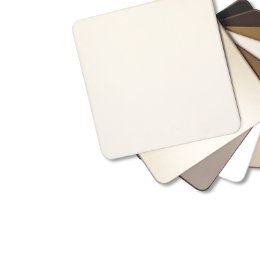Better Rainscreen Systems for High-Velocity Hurricane Zones

| Project: | Rainscreen cladding system for multistory buildings in high-velocity hurricane zones |
|---|---|
| Location: | Tested at ATI test lab in Atlanta; listed for use in Florida; suitable for costal hurricane zones from the Gulf of Mexico to the Eastern Seaboard |
| Fabricator/Installer: | System design jointly developed by ALPOLIC, Rmax and Altech |
| Architect | N/A |
| Exterior Panel Manufacturer: | ALPOLIC |
| Products: | R-TRAC HVHZ Pressure Equalized Rainscreen System, comprising ALPOLIC® ACM and MCM materials, Rmax foil-faced polyisocyanurate (polyiso) insulation sheathing, and Altech mounting system |
| Completion: | Florida approval FL16406 granted September 9, 2013 |
We ask a lot of our buildings. We expect them to keep us comfortable and safe, for decades on end, while withstanding the harshest weather conditions and minimizing the risk of fire and natural disasters. With stricter building codes for performance and safety, architects face a real challenge making building exteriors weatherproof, energy efficient, fire-resistant and impervious to hurricane-force winds and debris. ALPOLIC has teamed with Rmax and Altech to provide a system that does it all – easily and affordably.
If you want to build higher than 40 feet on the Florida coast – or essentially anywhere in high-velocity hurricane country where modern building codes are in effect – your building envelope needs to meet three criteria:
- It must comply with continuous insulation (CI) requirements specified by the 2012 ICC International Energy Conservation Code for the appropriate climate zone.
- It must pass NFPA 285 fire testing, required for multistory exterior non-load-bearing wall assemblies
- It must withstand the appropriate wind loading and missile impact standards for high-velocity hurricane zones – for example, the Testing Application Standards (201, 202, and 203) of the 2010 Florida Building Code and the windborne debris and missile impact standards of ASTM E1886 and E1996
No pressure-equalized rainscreen system incorporating cladding panels of aluminum or metal composite material (ACM or MCM) has been able to meet all these criteria. Until now.
Collaborating for a Better Rainscreen ACM Panel System
Rmax is a Texas-based manufacturer of foil-faced polyiso insulation. Altech Panel Systems is a Georgia-based fabricator of wall panel systems, with extensive experience building pressure-equalized rainscreen assemblies for high-velocity hurricane zones using ALPOLIC® ACM and MCM panels. ALPOLIC collaborated with these two industry leaders to create the first – and to date, the only – pressure-equalized rainscreen system using composite panels that satisfies all three criteria for multistory applications in hurricane zones.
Working together, we brought our solution from a cocktail-napkin idea to a fully designed, tested and approved system in only 18 months. Through innovative engineering, we replaced three traditional multistory firewall components – Type X gypsum board, insulation, and a water barrier system – with a single structural/insulation component from Rmax.
This simplification made the system more affordable – but even more important, it enabled us to create the first composite panel rainscreen system suitable for multistory applications in hurricane country.
Standing up to Hurricane-Force Winds
Type X gypsum board is typically specified for fire resistance in multistory buildings, but it tends to fracture at wind loads of 50 psf (pounds per square foot) and above. To achieve high-velocity hurricane zone ratings, materials must be able to withstand wind loads of up to 180 psf.
Because the Rmax foil-faced polyiso product provides the continuous insulation, water barrier and fire resistance we needed, our cocktail-napkin idea was to see whether it could withstand hurricane-force winds. At the ATI test lab in Atlanta, Georgia, we subjected the Rmax product to positive pressure up to 180 pfs. We did not overlay the Rmax with ALPOLIC panels, because we wanted to test the Rmax at 100 percent maximum wind load. The Rmax held even beyond the point where the steel studs it was mounted to buckled – a resounding success.
Under extreme negative pressure, however, the first mounting system we tried pulled through the Rmax. That’s where our joint development effort made the difference. Working together we perfected a mounting system that would hold the insulation firmly, without pulling through, at the negative pressures encountered during hurricane-force wind events. We even tested different fastener configurations to determine the minimum requirements needed to achieve various psf ratings – for example, 130, 150 and 180 psf. Based on these tests, we created a specification table to help customers choose the right configuration for their wind-load requirements without overpaying for unnecessary fasteners.
Standing up to Forceful Impacts and Fire
With the necessary continuous insulation and wind-loading requirements met, we still needed to test the system according to ASTM E1886/E1996 and TAS 201, 202 and 203 for resistance to impacts from tree limbs and debris that could be encountered in a hurricane. Also, despite being constructed entirely of fire-resistant materials, the system as a whole would need to pass the NFPA 285 fire test.
NFPA 285 is a test protocol used to determine the fire performance of combustible material in noncombustible exterior wall systems. It requires building a two-story building mockup, with enclosed rooms faced by the wall system and incorporating an opening representing a window in the lower story. Gas burners ignite inside the lower room and outside the opening, simulating a flashover with flames seeking the oxygen available on the outer wall. Flame height and wall temperature are continuously monitored, and the fire must not reach 10 feet above the top of the opening during the 30 minute test period.
ASTM E1886 and E1996 require testing the wall for resistance to hurricane-force impacts from objects ranging in size and mass from roof gravel to tree limbs. This involves shooting missiles as large as 2x4s from a special high-velocity cannon in an attempt to penetrate the ALPOLIC panels. These missile shots are followed by cycles of high positive and negative pressure. The assembly must survive with limited deformation or deflection.
The R-TRAC HVHZ Pressure Equalized Rainscreen System easily passed the fire and impact tests, and received Florida certification on September 9, 2013.
Pioneering Next-Generation Architectural Systems
In the rapidly evolving construction world, we expect you’ll see other multistory rainscreen systems for hurricane zones coming on the market in the next year or two. But we’re proud to have pioneered this application – and we’re confident you won’t find a competing system that offers the combination of beauty, durability and aesthetic choice you get only with ALPOLIC materials
For more information on the technical innovations, regulatory requirements and testing procedures behind this innovative rainscreen system, check out the Metal Architecture column written by Bill Yannetti of ALPOLIC, Doug McIntyre of Altech Panel Systems, and Jay Saldaña of Rmax. We think you’ll agree – these are some smart, dedicated engineers.






